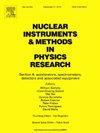利用深度神经网络识别Belle II K-Long和μ子探测器中的μ子
IF 1.4
3区 物理与天体物理
Q3 INSTRUMENTS & INSTRUMENTATION
Nuclear Instruments & Methods in Physics Research Section A-accelerators Spectrometers Detectors and Associated Equipment
Pub Date : 2025-07-29
DOI:10.1016/j.nima.2025.170814
引用次数: 0
摘要
μ子的识别在基本粒子物理实验中是至关重要的。在Belle II实验中,通过KL和Muon (KLM)子探测器(Belle II最外层子探测器)的穿透能力来区分动量大于0.7 GeV/c的μ子和介子。本文首先讨论了目前在Belle II实验中使用的μ子识别算法,指出了μ/π识别性能可能存在的改进空间,然后提出了一种基于深度神经网络(Deep Neural Network, DNN)的新方法。该DNN模型利用KLM命中模式变量作为输入,能够比现有算法更好地消化穿透信息。我们在模拟中测试了新方法,发现介子假率(特异性)从4.1%降低到1.6%,μ子效率(召回率)为90%。本文章由计算机程序翻译,如有差异,请以英文原文为准。
Muon identification with Deep Neural Network in the Belle II K-Long and Muon detector
Muon identification is crucial for elementary particle physics experiments. At the Belle II experiment, muons and pions with momenta greater than 0.7 are distinguished by their penetration ability through the and Muon (KLM) sub-detector, which is the outermost sub-detector of Belle II. In this paper, we first discuss the muon identification algorithm currently used in the Belle II experiment pointing out possible room for identification performance improvement and then present a new method based on Deep Neural Network (DNN). This DNN model utilizes the KLM hit pattern variables as the input and thus can digest the penetration information better than the current algorithm. We test the new method in simulation and find that the pion fake rate (specificity) is reduced from 4.1% to 1.6% at a muon efficiency (recall) of 90%.
求助全文
通过发布文献求助,成功后即可免费获取论文全文。
去求助
来源期刊
CiteScore
3.20
自引率
21.40%
发文量
787
审稿时长
1 months
期刊介绍:
Section A of Nuclear Instruments and Methods in Physics Research publishes papers on design, manufacturing and performance of scientific instruments with an emphasis on large scale facilities. This includes the development of particle accelerators, ion sources, beam transport systems and target arrangements as well as the use of secondary phenomena such as synchrotron radiation and free electron lasers. It also includes all types of instrumentation for the detection and spectrometry of radiations from high energy processes and nuclear decays, as well as instrumentation for experiments at nuclear reactors. Specialized electronics for nuclear and other types of spectrometry as well as computerization of measurements and control systems in this area also find their place in the A section.
Theoretical as well as experimental papers are accepted.

 求助内容:
求助内容: 应助结果提醒方式:
应助结果提醒方式:


